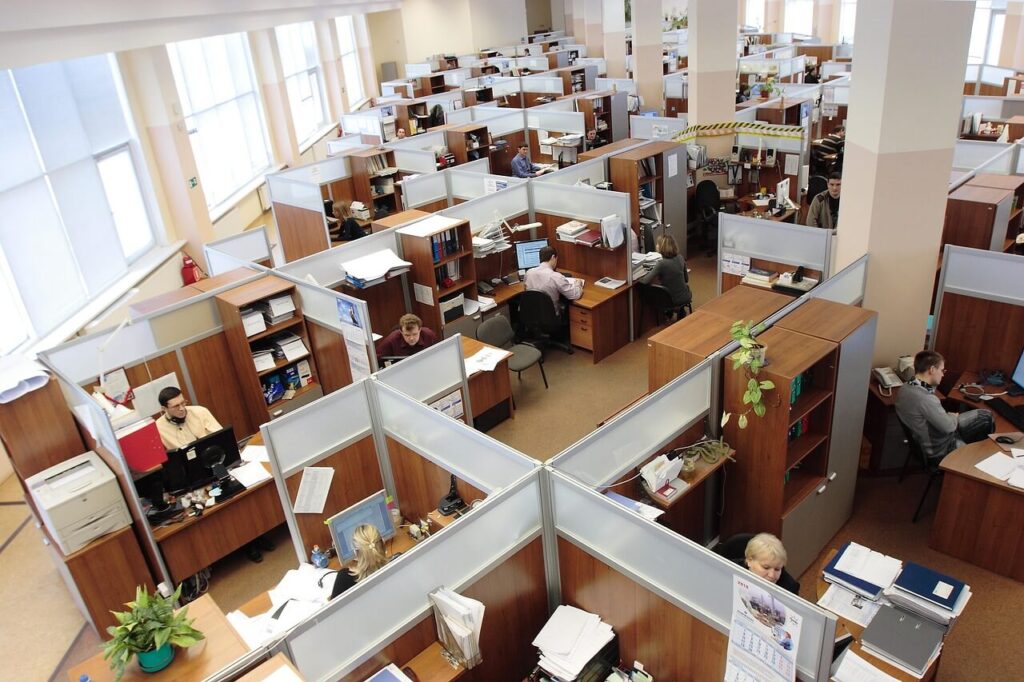As the shift toward remote work continues to shape the modern workforce, many businesses seek innovative ways to entice employees back into the office. Enter ‘office peacocking’, a growing trend where companies enhance their physical workspaces with eye-catching designs, stylish furniture, and luxury amenities. This approach taps into the latest office design trends, transforming workplaces into comfortable, collaborative environments that rival the home office.
From well-stocked office kitchens and comfortable office furniture to cosy communal spaces and break-out rooms, these modern office design trends are more than just cosmetic, they’re part of a broader strategy to make the office a place people want to return to.
What Is ‘Office Peacocking’?
Office peacocking refers to businesses enhancing their physical office spaces to entice employees back into the workplace, often in response to the growing preference for remote and hybrid work. The term draws inspiration from how peacocks display their vibrant feathers to attract attention, with companies similarly ‘showing off’ their office environments to make them more appealing to workers.
This trend is one of many modern office design trends that prioritise comfort and aesthetics. Office peacocking can involve everything from luxurious furniture and creative décor to fully stocked kitchens and recreational areas. Companies hope that by offering such upgraded spaces, they can compete with the allure of working from home and create a workplace that looks good and feels comfortable for employees.
The rise of this trend is part of a larger effort by businesses to adapt to the new realities of work in the post-pandemic era. As more employees seek flexibility, these office design trends aim to provide a compelling reason to return to the office, blending style, functionality, and collaboration opportunities into a more attractive package.
Why Are Employers Embracing This Popular Office Design Trend?
As remote work reshaped workplace dynamics, employers have realised that traditional office setups are no longer enough to lure employees back. To compete with the comfort and flexibility of working from home, businesses are turning to office peacocking and leveraging modern office design trends to create more attractive and engaging work environments.
One driving factor behind this trend is employee resistance to returning full-time. According to a 2023 report by Owl Labs, 31% of employees said they would look for a new job if forced to return to the office full-time. Additionally, many employees indicated they would accept a pay cut to maintain flexibility in their work arrangements. This highlights a growing demand for work-life balance and flexibility, which employers address through enhanced office spaces.
By integrating popular office design trends, such as cosy lounges, aesthetically pleasing furniture, and collaborative spaces, employers aim to provide an environment that feels more like a creative, comfortable hub than a typical office.
Elements That Help Entice Workers Back To Traditional Office Environments
The success of office peacocking relies on more than flashy décor; it’s about creating functional and inviting workspaces that employees will want to come to work in. Pairing employee needs and wants with elements of the office peacocking trend could have the positive impact that business owners are looking for.
One aspect that research has found is that employees value greater privacy when working in a traditional office. Compared to working from home, traditional office spaces would need to provide more privacy for employees if there are any hopes of employees enjoying being back in an office. Meeting pods are quite popular office features right now that help provide extra space and privacy in open-plan offices.
Meeting pods are just one aspect that can maximise small office spaces and add multifunctional furniture where needed most. Such office furniture can provide much-needed privacy that employees are looking for; whether for meetings, team brainstorming, or solitary work.
Alongside improved furniture, transforming communal areas plays a role in the office peacocking trend. Generously stocked office kitchens and comfortable furniture can transform old kitchens and break areas to motivate employees to spend more time there.
As hybrid working has become the norm for many businesses, there have also been changing attitudes towards office dress codes. Outside of office peacocking, research found that 1 in 4 employees would be enticed to return to the office if they could wear what they wanted.
Is Office Peacocking Enough? Flexibility Remains A Key Priority For Employees
While office peacocking can make the workplace more visually appealing and comfortable, the question remains: does it improve employee satisfaction enough to lure workers back full-time?
A key aspect of why employees prefer working from home is the flexibility it provides. Right now, flexible office spaces are a popular type of office for startup businesses as they are adaptable and inexpensive compared to other options. Providing flexible workspaces in a traditional office space caters to everyone’s needs and work styles. Including areas for collaboration, relaxation spots, and quiet places for focused work can boost productivity and morale.
Flexibility still reigns supreme for many workers, with over 62% willing to accept a pay cut to maintain remote or hybrid work options. While modern office design trends can enhance the in-office experience, they need to be paired with policies that support work-life balance and autonomy.
Ultimately, office peacocking can transform a workspace into a more desirable environment but the true key to employee satisfaction lies in blending these design upgrades with the flexibility that workers have grown to value.




